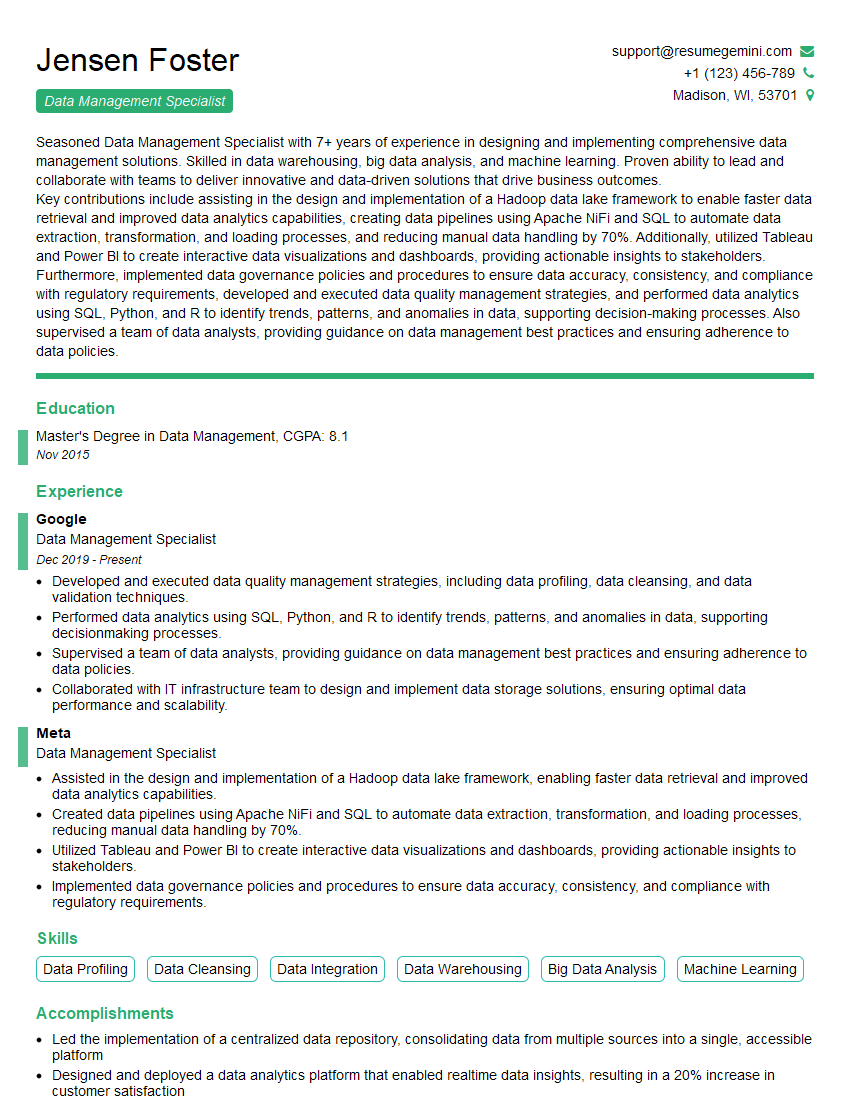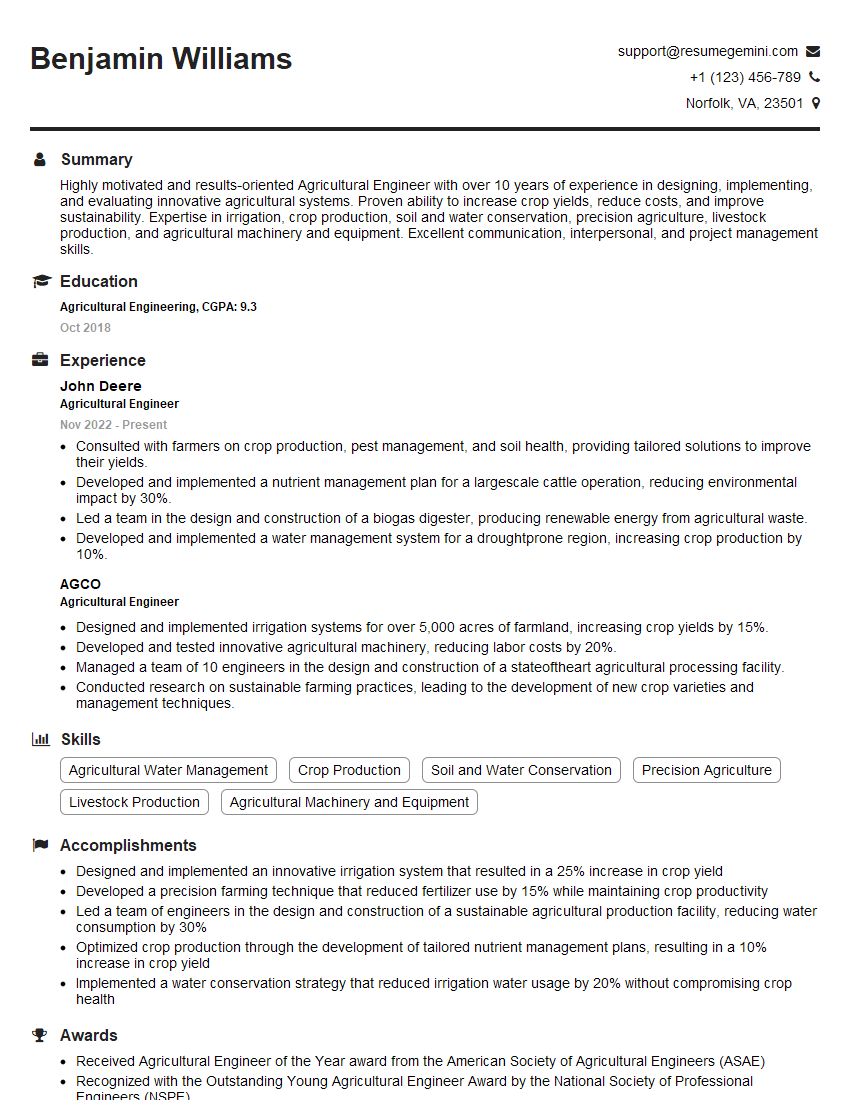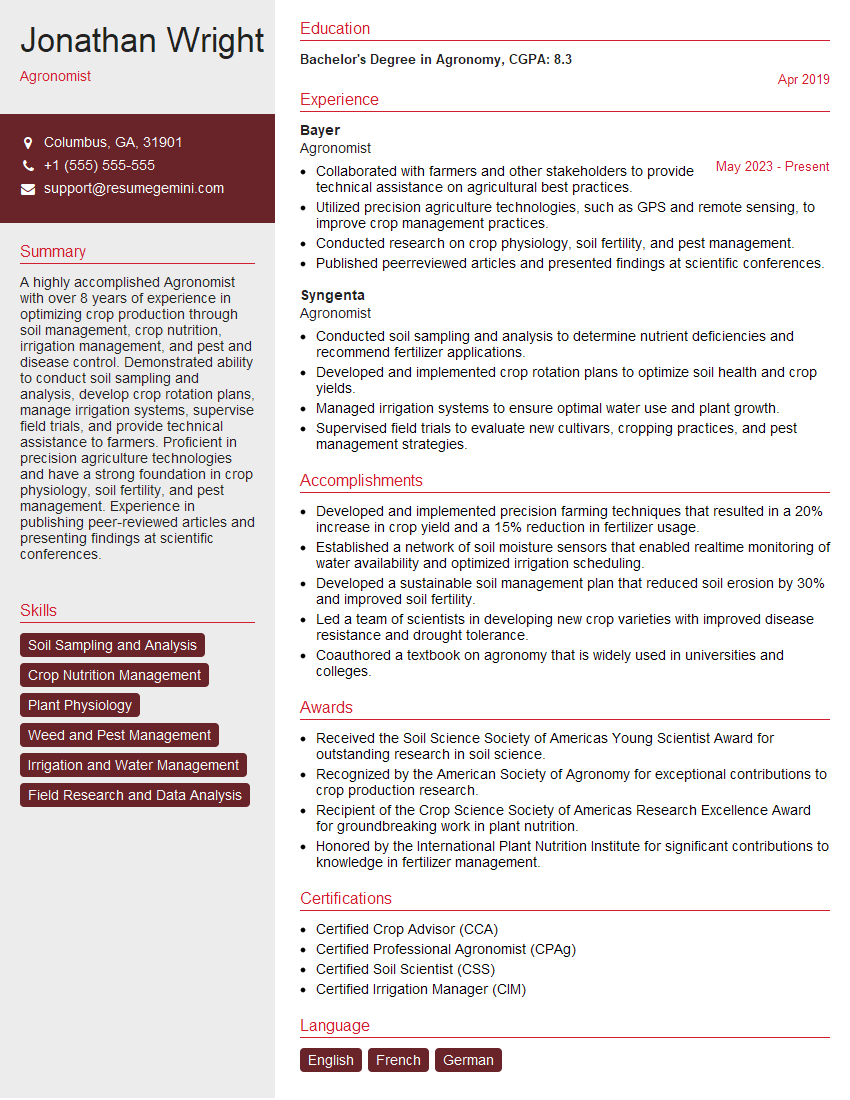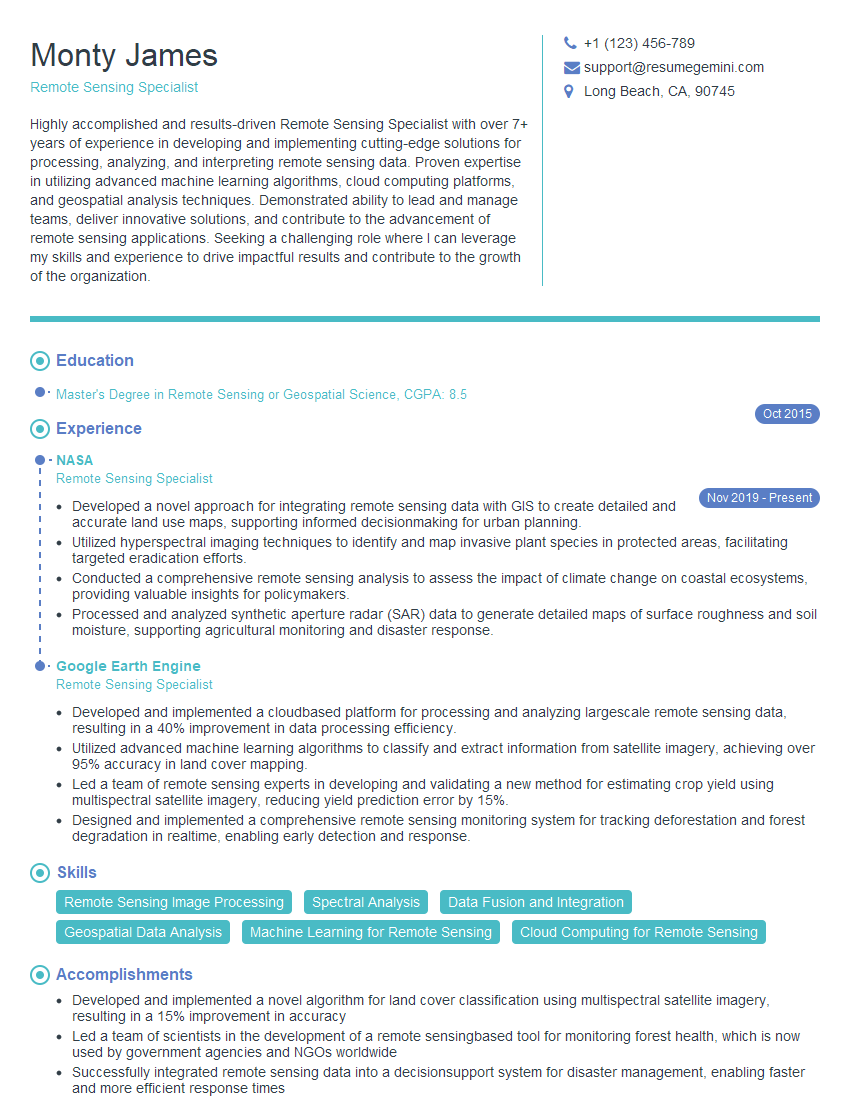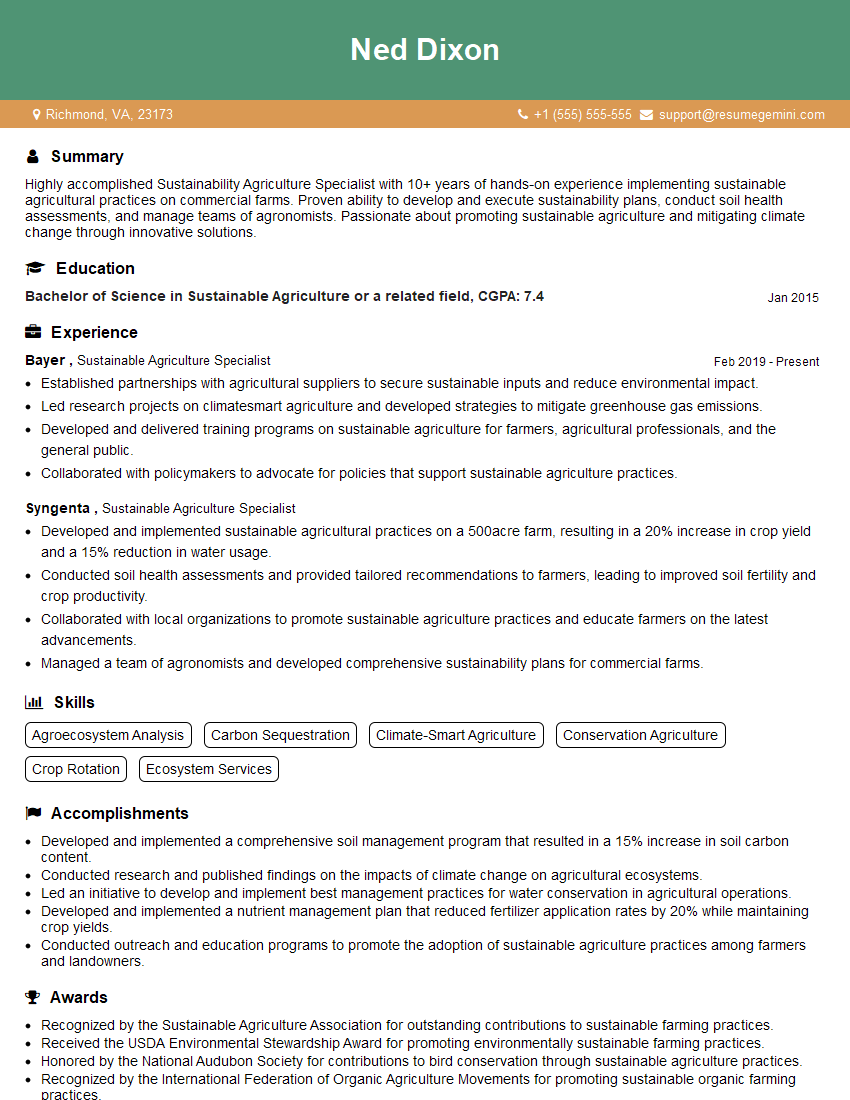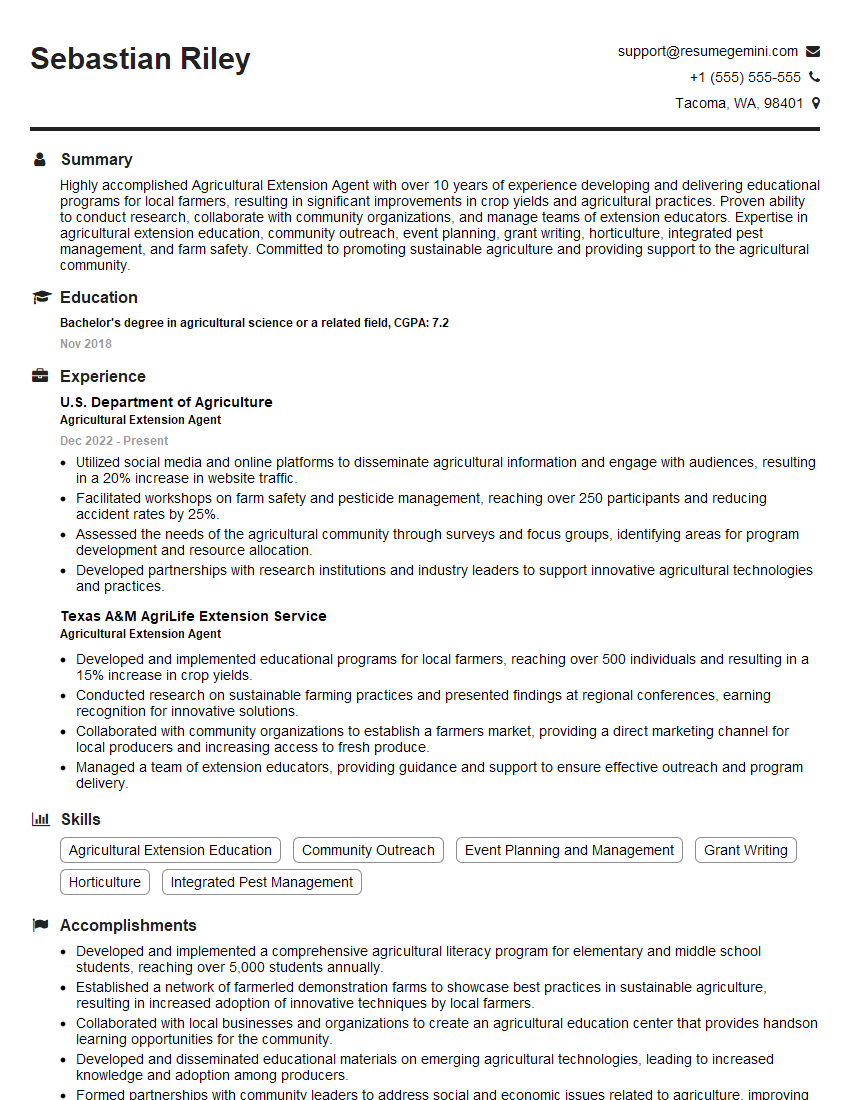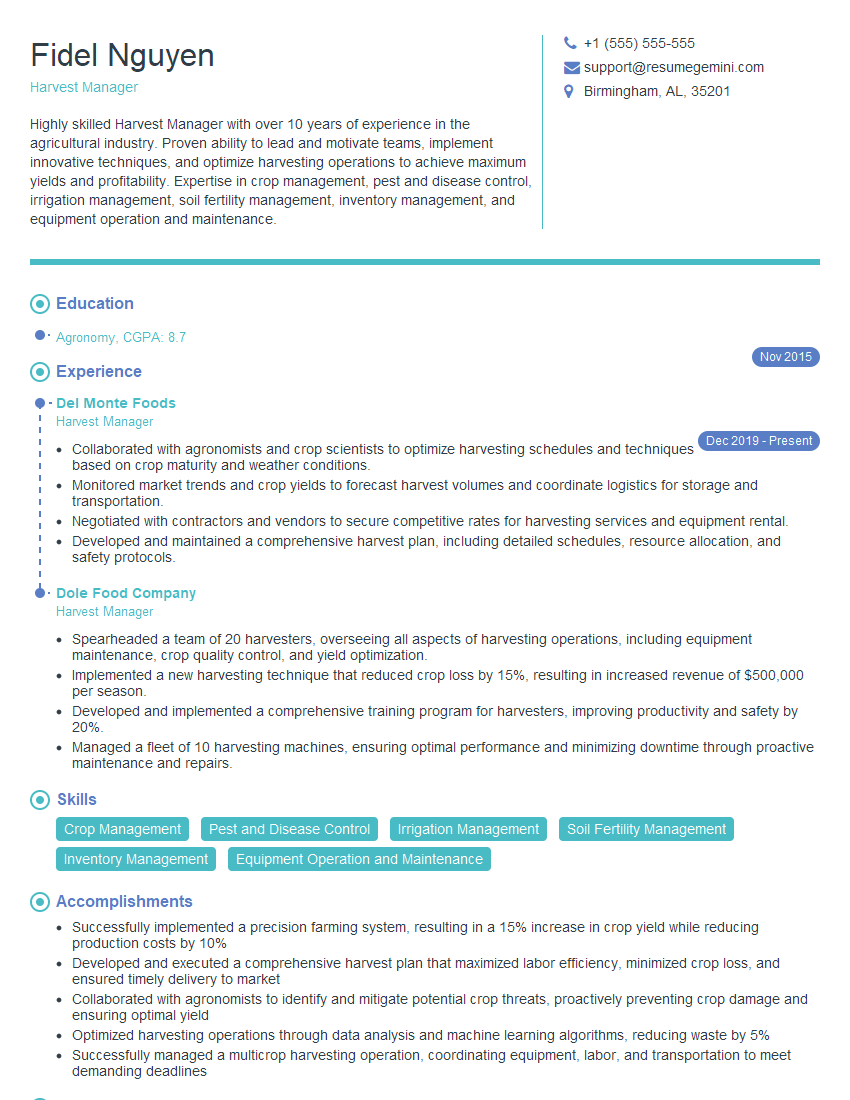Interviews are more than just a Q&A session—they’re a chance to prove your worth. This blog dives into essential Crop Monitoring and Evaluation interview questions and expert tips to help you align your answers with what hiring managers are looking for. Start preparing to shine!
Questions Asked in Crop Monitoring and Evaluation Interview
Q 1. Explain the different methods used for crop monitoring, including remote sensing and ground-truthing.
Crop monitoring employs various methods to assess plant health and yield potential. These methods broadly fall into two categories: remote sensing and ground-truthing.
Remote Sensing involves acquiring data from a distance, primarily using aerial platforms like drones or satellites. This provides a large-scale overview of the field. Different types of remote sensing include:
- Multispectral imagery: Captures images across various wavelengths of light, revealing information invisible to the human eye, such as chlorophyll content indicating plant health.
- Hyperspectral imagery: Provides even finer spectral resolution than multispectral, offering more detailed insights into plant biochemistry.
- Thermal imagery: Measures temperature differences, useful for detecting water stress or disease affecting plant temperature.
- LiDAR: Uses lasers to create 3D models of the crop canopy, providing insights into plant height and density.
Ground-truthing involves on-site measurements to validate data gathered through remote sensing. This might include:
- Visual assessments: Examining plants for signs of stress, disease, or nutrient deficiencies.
- Plant sampling: Collecting samples for laboratory analysis of nutrient content, disease presence, or other factors.
- Yield measurements: Determining the actual yield at harvest to correlate with remote sensing data.
Combining remote sensing with ground-truthing ensures accurate and reliable crop assessments. Remote sensing provides a broad overview, while ground-truthing provides precise details to calibrate and refine the remote sensing data.
Q 2. Describe your experience with different types of agricultural sensors and their applications.
My experience encompasses a wide range of agricultural sensors, each with unique applications. For example:
- Multispectral cameras (on drones or satellites): I’ve extensively used these to generate NDVI (Normalized Difference Vegetation Index) maps, identifying areas of healthy and stressed vegetation. A project I worked on utilized a MicaSense RedEdge camera to monitor a large vineyard, pinpointing areas needing irrigation or pest control.
- Soil moisture sensors: These provide critical data on water availability, allowing for precise irrigation scheduling and preventing water stress. I’ve integrated data from these sensors with weather data to create predictive models for irrigation needs.
- Leaf chlorophyll meters: These handheld devices directly measure chlorophyll content, offering a quick and localized assessment of plant health. This is invaluable for rapid field scouting.
- Thermal cameras: These have been essential in identifying areas experiencing heat stress, often an early indicator of drought or disease. In one instance, we used thermal imagery to detect a fungal infection in a cornfield before it became visually apparent.
The selection of sensors depends heavily on the crop, the specific monitoring goals, and the budget available. I am adept at choosing and integrating the most appropriate sensor technologies for a given application.
Q 3. How do you analyze crop health data derived from multispectral imagery?
Analyzing crop health data from multispectral imagery typically involves several steps. First, the raw imagery undergoes atmospheric correction to remove distortions caused by the atmosphere. Then, various vegetation indices (VIs) are calculated. The most common is the NDVI, calculated as:
(NIR - Red) / (NIR + Red)where NIR is the near-infrared reflectance and Red is the red reflectance. NDVI values range from -1 to +1, with higher values indicating healthier vegetation. Other VIs, such as SAVI (Soil-Adjusted Vegetation Index) and EVI (Enhanced Vegetation Index), are used to address limitations of NDVI, particularly in areas with bare soil or high biomass.
These indices are then used to create maps visualizing the spatial variation in crop health. Further analysis can involve:
- Statistical analysis: Calculating descriptive statistics (mean, standard deviation, etc.) to quantify overall crop health.
- Spatial analysis: Identifying areas with unusually high or low VI values, indicating potential problems or variations in growth.
- Time-series analysis: Monitoring changes in VI values over time to track crop growth and identify stress events.
- Machine learning: Training algorithms on VI data and ground-truth measurements to predict yield or detect specific diseases.
The final output is a comprehensive assessment of crop health, guiding decision-making for management practices like irrigation, fertilization, and pest control.
Q 4. What are the key indicators of crop stress visible in aerial imagery?
Aerial imagery reveals several key indicators of crop stress. These visual cues often manifest as:
- Changes in color: Stressed plants might exhibit yellowing (chlorosis), browning (necrosis), or reddening, depending on the type of stress (water, nutrient, or disease).
- Reduced vigor: Stressed plants will often be shorter and less dense than healthy plants, leading to visible gaps in the canopy.
- Wilting: Water stress is easily visible as wilting or drooping leaves.
- Unusual patterns: Patches of stressed plants might indicate localized problems like soil compaction, pest infestations, or disease outbreaks.
- Changes in spectral reflectance: As mentioned before, multispectral imagery shows variations in reflectance across different wavelengths that correlate with stress levels.
The specific indicators vary based on the type of crop and the type of stressor. For example, nitrogen deficiency might manifest as yellowing in younger leaves, while drought stress might cause general wilting and reduced canopy cover. Identifying these patterns requires a combination of experience and understanding of crop physiology.
Q 5. Explain your experience with GIS software for agricultural applications.
My expertise with GIS software (like ArcGIS, QGIS) is extensive, and it’s integral to my work in agricultural applications. I use GIS to:
- Georeference imagery: Accurately positioning aerial imagery and sensor data on a map.
- Create thematic maps: Visualizing crop health data using different classifications and color schemes to highlight areas needing attention.
- Perform spatial analysis: Analyzing the spatial distribution of crop characteristics and identifying patterns or relationships.
- Integrate multiple data layers: Combining data from different sources (topographical data, soil maps, weather data) to create a comprehensive picture.
- Develop decision support systems: Creating interactive maps and tools to aid in farm management decisions.
For example, in a recent project, I used ArcGIS to overlay NDVI maps with soil moisture data to identify areas experiencing both water stress and nutrient deficiencies. This allowed for targeted irrigation and fertilization, optimizing resource use.
Q 6. How do you integrate data from various sources (e.g., sensors, weather stations, historical data) for a comprehensive crop assessment?
Integrating data from multiple sources is essential for a comprehensive crop assessment. This usually involves a multi-step process:
- Data acquisition: Collecting data from various sources – sensors, weather stations, historical yield records, soil data, etc. Data formats may vary, requiring conversion and standardization.
- Data preprocessing: Cleaning and preparing the data for analysis. This may include handling missing values, smoothing noisy data, and performing georeferencing.
- Data integration: Combining data from multiple sources using a GIS or database system. Spatial alignment is often necessary. This could involve creating a relational database connecting sensor data to geographic coordinates and environmental parameters.
- Data analysis: Using statistical and spatial analysis techniques to identify patterns and relationships in the integrated data. This often employs correlations and regression analyses.
- Model development: For example, using machine learning to predict yield based on the combined data or forecast stress events.
For instance, I’ve integrated data from drones, weather stations, and historical yield data to build a predictive model that forecasts yield with high accuracy, allowing farmers to make informed decisions on resource allocation.
Q 7. Describe your experience with yield monitoring equipment and data interpretation.
My experience with yield monitoring equipment includes working with yield monitors integrated into combine harvesters. These devices measure yield in real-time, providing valuable data for assessing yield variability across the field. The data typically includes yield in bushels per acre or similar units, along with GPS coordinates to spatially map yield.
Interpreting yield monitor data involves:
- Data cleaning and processing: Removing outliers and inconsistencies.
- Yield mapping: Creating yield maps to visualize yield variability across the field.
- Correlation with other data: Analyzing relationships between yield and factors like soil conditions, planting date, and management practices (e.g., comparing yield maps with NDVI maps from earlier in the season).
- Identifying high and low yield zones: Understanding the causes of yield variability to inform future management decisions.
By combining yield data with other datasets, I can pinpoint management factors leading to yield loss and help develop strategies to increase productivity and profitability. For example, consistently low yields in a particular field area could point to a drainage issue which can be addressed to improve the yield.
Q 8. How do you identify and quantify crop diseases or pest infestations using remote sensing data?
Identifying and quantifying crop diseases or pest infestations using remote sensing data involves analyzing spectral signatures captured by sensors like those on satellites or drones. Healthy vegetation has a distinct spectral reflectance pattern, which changes when affected by stress factors like diseases or pests. We look for deviations from this ‘normal’ pattern.
For example, a disease might cause a change in the plant’s chlorophyll content, leading to a decrease in near-infrared reflectance and an increase in red reflectance. This is easily visualized on a Normalized Difference Vegetation Index (NDVI) map, where healthy vegetation shows high values and stressed vegetation shows lower values. We can then use image classification techniques, often employing machine learning algorithms (like Support Vector Machines or Random Forests), trained on labeled datasets (ground truth data collected in the field), to map the extent of the infestation or disease. Quantification comes through calculating the area affected by analyzing the classified image and converting pixel counts to hectares.
Another approach is to look for specific spectral features associated with particular pathogens. For instance, some fungal diseases produce characteristic changes in the mid-infrared region, allowing for their identification through spectral unmixing techniques. The intensity of these spectral changes can be correlated with disease severity, providing a quantitative measure of infestation.
Q 9. What are the limitations of using remote sensing for crop monitoring?
While remote sensing offers powerful capabilities for crop monitoring, limitations exist. Firstly, atmospheric conditions like clouds or haze can obscure the view, leading to missing data or inaccurate measurements. Spatial resolution of the imagery is also a factor; high-resolution imagery is more accurate but often more expensive and less readily available than lower-resolution data. The resolution might not be fine enough to detect small, localized infestations.
Temporal resolution is crucial; frequent monitoring is needed to capture the dynamic nature of crop growth and disease development. Infrequent data acquisition might miss critical events. Sensor limitations also play a role; different sensors have varying spectral ranges and sensitivities, affecting the accuracy and precision of the results. Moreover, ground truthing (the process of verifying remotely sensed data with on-site observations) is crucial but can be time-consuming and costly, limiting the scale of validation.
Finally, interpreting complex spectral information often requires sophisticated data processing and analysis techniques, demanding specialized skills and computational resources.
Q 10. Explain your experience in developing crop management recommendations based on monitoring data.
In my previous role, I developed a system for generating site-specific crop management recommendations based on remotely sensed data combined with weather information and soil data. The system used multispectral imagery to assess crop health and growth stages. For instance, if NDVI values indicated early signs of stress in a corn field, the system would trigger alerts. Combining this with weather data (e.g., prolonged periods of drought), the system generated recommendations for irrigation scheduling. Similarly, if the imagery showed signs of disease or pest infestation, it could trigger recommendations for targeted pesticide or fungicide applications, including the specific type and dosage.
The recommendations were tailored to specific locations within the field, recognizing the variability in crop conditions. This precision approach, guided by monitoring data, helped optimize resource use and improve yields compared to blanket management practices. We validated these recommendations via field trials, observing significant improvements in crop yields and reduced input costs. We also incorporated farmer feedback into the system, continually improving its accuracy and relevance.
Q 11. How do you ensure the accuracy and reliability of crop monitoring data?
Ensuring data accuracy and reliability is paramount. We employ several strategies. First, data quality control is essential. This includes atmospheric correction (removing atmospheric effects from the raw data) and geometric correction (registering the imagery to a map coordinate system). Regular sensor calibration and validation procedures are critical.
Second, ground truthing involves collecting field measurements (e.g., disease severity, plant height) at various locations within the monitored area to validate the remotely sensed data. We use statistical methods to compare the remotely sensed data with the ground truth data to assess the accuracy of our estimations. Third, we use multiple data sources to cross-validate our findings. This might include integrating remotely sensed data with weather station data, soil sensor data, and historical yield records to build a more comprehensive understanding.
Finally, rigorous quality assurance and quality control (QA/QC) procedures are followed throughout the process, from data acquisition to data analysis and interpretation, to identify and minimize potential errors.
Q 12. Describe your experience with statistical analysis methods used in crop monitoring.
Statistical analysis is crucial in crop monitoring. We frequently use regression analysis to model the relationship between remotely sensed indices (like NDVI) and crop variables like biomass or yield. For example, we might build a linear regression model to predict yield based on the average NDVI value over the growing season. Time series analysis is used to analyze changes in crop conditions over time, allowing us to detect trends and anomalies.
Spatial statistics, like geostatistics, are employed to account for spatial autocorrelation in the data (the tendency of nearby locations to have similar values) and to create maps of crop parameters. Classification algorithms, like those mentioned previously, are used to classify pixels in satellite imagery into different categories representing different crop types, health conditions, or stress levels. We also use hypothesis testing to assess the statistical significance of our findings and to evaluate the effectiveness of different management strategies.
Q 13. What are the different types of crop models used for predicting yield?
Crop models are used for yield prediction by simulating the growth and development of crops under different environmental conditions. Different types exist, ranging from simple empirical models to complex process-based models.
- Empirical models are statistical models that relate yield to easily measured variables like temperature, rainfall, and planting date. They are relatively simple but might not capture the complexity of plant processes.
- Process-based models simulate the physiological processes of crops, accounting for factors such as photosynthesis, respiration, water use, and nutrient uptake. They are more complex but can provide more accurate predictions under diverse conditions. Examples include the DSSAT (Decision Support System for Agrotechnology Transfer) model and the APSIM (Agricultural Production Systems Simulator) model.
The choice of model depends on the specific application and the data available. Simple models are suitable when data are limited, whereas complex models are preferred when detailed information on crop physiology and environmental factors is accessible.
Q 14. How do you handle missing or incomplete data in crop monitoring datasets?
Handling missing or incomplete data is a common challenge in crop monitoring. Several strategies can be used, depending on the extent and nature of the missing data.
- Simple imputation techniques, such as replacing missing values with the mean, median, or mode of the available data, can be used if the amount of missing data is small. However, this can bias the results if the missing data are not randomly distributed.
- More sophisticated imputation methods, such as k-nearest neighbor imputation or multiple imputation, can be used to estimate missing values based on the values of nearby observations or other variables. These methods generally produce less biased estimates than simple imputation.
- Spatial interpolation techniques, such as kriging, can be used to estimate missing values based on the spatial distribution of the available data. This is particularly useful for spatial data like remotely sensed imagery.
- Data augmentation is another strategy which creates synthetic data from existing data to help in model training. This is especially helpful when the dataset is small.
The choice of technique depends on the amount and pattern of missing data, the nature of the variable, and the goals of the analysis. It’s crucial to document the chosen method and assess its potential impact on the results.
Q 15. Explain your experience with different types of data visualization techniques for agricultural data.
Data visualization is crucial for understanding complex agricultural datasets. I’ve extensively used various techniques, tailoring my approach to the specific data and audience. For instance, geospatial visualizations like maps are indispensable for showing field-level variations in crop health, using color-coding to represent NDVI (Normalized Difference Vegetation Index) values. High NDVI indicates healthy vegetation, while low values suggest stress. I’ve used GIS software like ArcGIS and QGIS to create these maps, often overlaying them with other data layers like soil type or topography for a more comprehensive analysis.
Beyond maps, time-series graphs are vital for tracking crop growth over time. These graphs visually represent changes in key parameters like biomass, yield predictions, or the impact of interventions like fertilization or irrigation. I often use interactive dashboards built with tools like Tableau or Power BI to allow stakeholders to explore this data dynamically.
Furthermore, scatter plots are useful for exploring correlations between variables. For example, plotting rainfall against yield can reveal the relationship between precipitation and crop productivity. Finally, bar charts and pie charts are helpful for summarizing key metrics and presenting them in a concise and easily digestible format to a non-technical audience.
Career Expert Tips:
- Ace those interviews! Prepare effectively by reviewing the Top 50 Most Common Interview Questions on ResumeGemini.
- Navigate your job search with confidence! Explore a wide range of Career Tips on ResumeGemini. Learn about common challenges and recommendations to overcome them.
- Craft the perfect resume! Master the Art of Resume Writing with ResumeGemini’s guide. Showcase your unique qualifications and achievements effectively.
- Don’t miss out on holiday savings! Build your dream resume with ResumeGemini’s ATS optimized templates.
Q 16. Describe your experience with precision farming technologies and their integration with crop monitoring.
Precision farming technologies are transformative for crop monitoring. My experience includes integrating data from various sources, such as GPS-guided machinery, remote sensing (drones and satellites), and in-field sensors. For example, I’ve worked with variable-rate technology (VRT) where fertilizer or pesticide application is adjusted based on real-time data on crop needs. This optimization reduces input costs and minimizes environmental impact.
I’ve also worked with sensors that measure soil moisture, temperature, and nutrient levels. This data is integrated with remote sensing data and weather forecasts to create a comprehensive picture of crop health and guide decision-making. For example, if soil moisture sensors indicate low levels in a specific area, irrigation can be targeted to that area, saving water and resources. The integration involves data cleaning, processing, and analysis using programming languages like Python and R, employing libraries like Pandas and scikit-learn for data manipulation and statistical modeling.
Real-time data transmission through IoT (Internet of Things) devices enables immediate responses to changing conditions. This allows for proactive adjustments in irrigation, fertilization, and pest control, leading to optimized resource use and increased yields. For instance, detecting early signs of disease through hyperspectral imagery from drones allows for timely intervention, preventing widespread outbreaks.
Q 17. How do you communicate complex crop monitoring data to farmers or stakeholders?
Communicating complex data to farmers and stakeholders requires a nuanced approach. I avoid technical jargon and use simple, visual representations that are easy to understand. I’ve found that interactive dashboards are particularly effective, as they empower users to explore the data at their own pace. These dashboards often incorporate maps, graphs, and summary tables, making complex information readily accessible.
I also conduct regular field visits and on-site demonstrations to explain the findings and answer questions. I often translate data into practical recommendations, focusing on the implications for management decisions. For instance, instead of merely presenting NDVI values, I explain what they mean in terms of potential yield reduction or the need for specific interventions.
Furthermore, storytelling is a powerful tool. I weave the data analysis into narratives that resonate with farmers’ experiences and challenges. This approach makes the information more relatable and memorable, leading to better adoption of data-driven insights. Training workshops and one-on-one consultations play a crucial role in ensuring that the information is understood and correctly applied.
Q 18. What are the key factors influencing crop yield variation?
Crop yield variation is a complex phenomenon influenced by a multitude of interacting factors. These can be broadly categorized into biotic (living organisms) and abiotic (non-living factors).
- Abiotic Factors: These include weather conditions (temperature, rainfall, sunlight, frost), soil properties (nutrient availability, water holding capacity, pH, texture), and topography (slope, elevation).
- Biotic Factors: These encompass pests and diseases, weed competition, and the crop’s genetic makeup (variety selection, planting density). Management practices such as fertilization, irrigation, and pest control also significantly influence yield.
The interplay between these factors is crucial. For example, a drought (abiotic) can make a crop more susceptible to pests (biotic), exacerbating yield loss. Understanding these interactions is essential for developing effective crop management strategies.
Q 19. How do you utilize weather data in your crop monitoring and evaluation processes?
Weather data is integral to crop monitoring and evaluation. I integrate various weather parameters, including temperature, rainfall, solar radiation, and wind speed, into my analyses. This is often done through the use of weather stations, publicly available weather datasets, and weather forecasting models. I use historical weather data to understand long-term trends and to establish baseline conditions.
Real-time weather data is particularly important for predicting potential risks like drought stress, heat stress, or frost damage. For example, by combining weather forecasts with crop growth models, I can predict when irrigation is needed or when frost protection measures might be necessary. This proactive approach helps minimize yield losses and optimize resource allocation. Predictive analytics using machine learning models can also be incorporated to enhance the accuracy and timeliness of these predictions.
I often use specialized software and platforms that integrate weather data with other crop monitoring data. This allows me to visualize the impact of weather events on crop growth, providing a clear picture of the factors influencing yield variation and guiding decision-making.
Q 20. Describe your experience with developing and implementing crop monitoring protocols.
Developing and implementing crop monitoring protocols involves a systematic approach. It starts with defining clear objectives, such as assessing crop health, predicting yield, or optimizing resource use. Next, the appropriate data acquisition methods are selected. This might involve remote sensing (satellite or drone imagery), ground-based sensors, or a combination of both. The chosen methods are highly dependent on the specific crop, the scale of the operation, and the available resources.
Data processing and analysis are critical steps, involving techniques like image processing, statistical analysis, and modeling. Quality control measures are implemented to ensure data accuracy and reliability. Finally, the findings are interpreted, communicated to stakeholders, and used to inform management decisions. This process is iterative; feedback from stakeholders is incorporated to refine the protocol over time.
An example of a protocol I’ve developed involved using NDVI from satellite imagery to assess the health of a large-scale corn field. The protocol detailed the frequency of image acquisition, the image processing steps, the NDVI thresholds used to identify stress areas, and the communication strategies for sharing results with the farm manager.
Q 21. What are the economic implications of inaccurate crop monitoring and evaluation?
Inaccurate crop monitoring and evaluation can have significant economic consequences. Underestimation of yields can lead to under-selling of crops, resulting in lost revenue. Conversely, overestimation might lead to under-production and unmet market demands, impacting profitability. Inaccurate assessments of crop health can lead to delays in implementing necessary interventions (e.g., pest control, irrigation), which might result in substantial yield losses.
Misallocation of resources due to inaccurate information is another major concern. This includes inefficient use of fertilizers, pesticides, water, and labor, leading to increased costs and reduced returns. In the context of insurance, inaccurate assessments of crop damage can lead to disputes and financial losses for both farmers and insurance companies. Consequently, accurate and timely crop monitoring is crucial for informed decision-making, resource optimization, and financial stability in agriculture.
Q 22. Explain your experience with soil health monitoring and its relationship to crop health.
Soil health is the foundation of robust crop production. Monitoring soil health involves assessing key parameters like organic matter content, nutrient levels (nitrogen, phosphorus, potassium), pH, soil structure, and water holding capacity. These factors directly influence nutrient availability, water infiltration, root growth, and overall plant vigor. For instance, low organic matter can lead to poor water retention and reduced nutrient availability, impacting crop yield and quality. My experience includes using various methods for soil health monitoring: soil sampling and laboratory analysis for precise nutrient and organic matter quantification; using soil probes to assess moisture content and electrical conductivity in situ; and employing spectral sensors to map soil properties across larger fields. Analyzing this data allows us to identify areas needing targeted amendment applications, such as fertilizers or compost, optimizing resource use and improving crop yields. A specific example from my work involved a corn field showing uneven growth. Soil testing revealed low potassium in a specific section. Targeted potassium fertilization in that section resulted in a significant yield improvement in that area compared to the rest of the field, highlighting the direct link between soil health monitoring and optimized crop management.
Q 23. How do you assess the effectiveness of different crop management strategies based on monitoring data?
Assessing the effectiveness of crop management strategies relies heavily on comparing monitored data before, during, and after implementing those strategies. This involves establishing baseline data before any intervention, using various monitoring techniques— remote sensing (e.g., NDVI from drones or satellites), ground-based sensors, and manual measurements (yield, plant height etc.). For example, if comparing conventional tilling vs. no-till farming, we might monitor soil erosion rates, water usage, and crop yields. Statistical analysis (e.g., t-tests, ANOVA) helps determine if the differences observed are statistically significant. Visualizations like graphs and maps aid in interpreting the data and identifying areas of improvement. A case study I conducted compared the effects of different irrigation schedules on water stress in vineyards. By monitoring leaf water potential and yield components, we found that a deficit irrigation strategy, implemented based on soil moisture sensor data, resulted in similar yields with significantly reduced water consumption compared to conventional irrigation. This data clearly demonstrated the effectiveness of precision irrigation strategies.
Q 24. Describe your experience with using machine learning or AI in crop monitoring.
Machine learning and AI have revolutionized crop monitoring, allowing for more efficient and accurate analysis of large datasets. I have experience using various AI techniques, including deep learning models for image classification (disease detection, weed identification) and predictive modeling (yield prediction, fertilizer recommendation). For example, I’ve used convolutional neural networks (CNNs) to analyze drone imagery for early detection of plant diseases like blight in potato fields. The CNN was trained on a large dataset of labeled images, enabling accurate identification of disease symptoms even in their early stages, allowing for timely intervention. Another project involved developing a predictive model, using regression algorithms, to forecast yield based on weather data, soil parameters, and historical yield records. These models significantly improved yield prediction accuracy compared to traditional methods. The integration of AI into crop monitoring workflows increases automation, reduces human error, and ultimately leads to better decision-making.
Q 25. What are the ethical considerations related to data collection and use in precision agriculture?
Ethical considerations in precision agriculture revolve around data privacy, security, and responsible use. Data collected from farmers’ fields, including geolocation, yields, and other sensitive information, must be handled responsibly. This requires robust data security protocols, transparency in data usage policies, and informed consent from farmers. There are concerns about potential biases in algorithms that might disproportionately affect certain farmers or regions. For example, a yield prediction model trained predominantly on data from large farms might not be accurate for smaller, diversified farms. Another ethical issue is the potential for data exploitation, where collected data is used for purposes beyond what the farmer agreed to. A strong ethical framework should include clear guidelines on data ownership, access control, and the use of AI to ensure fair and equitable outcomes for all stakeholders in the agricultural community. This includes building trust and ensuring that farmers understand the implications of sharing their data.
Q 26. How do you stay updated on the latest advancements in crop monitoring technologies?
Staying updated in this rapidly evolving field requires a multi-pronged approach. I regularly attend conferences and workshops focused on precision agriculture and remote sensing. I actively follow leading research journals and publications, including Remote Sensing of Environment and Precision Agriculture. I participate in online communities and forums, exchanging ideas and best practices with other professionals. I also leverage online courses and webinars from universities and industry leaders to deepen my understanding of new technologies and techniques. Following industry leaders on social media and subscribing to newsletters keeps me up-to-date on the latest developments and product releases. This combined approach ensures I am always learning and adapting to the latest innovations in crop monitoring.
Q 27. Describe your experience in troubleshooting and resolving issues related to crop monitoring equipment or software.
Troubleshooting crop monitoring equipment and software requires a systematic approach. It starts with clearly defining the problem. Is it a hardware issue (sensor malfunction, communication errors) or software issue (data processing errors, algorithm bugs)? For hardware problems, I systematically check connections, power supplies, and sensor calibration. I also look at environmental factors such as extreme weather conditions that may impact sensor readings. For software issues, I utilize debugging tools, check log files for error messages, and review the code to identify the source of the problem. Sometimes, it involves updating software or firmware. Collaboration is crucial – if I cannot resolve the issue independently, I engage with technical support teams from equipment or software vendors. Documenting all troubleshooting steps and resolutions is essential for future reference and improved efficiency. A recent example involved a malfunctioning drone which was unable to record aerial imagery. Through systematic checks, I identified a faulty battery connection and resolved the issue, preventing delays in crop monitoring activities.
Key Topics to Learn for Crop Monitoring and Evaluation Interview
- Remote Sensing Techniques: Understanding the principles of satellite imagery, aerial photography, and drone-based data acquisition for crop monitoring. Practical application: Analyzing NDVI indices to assess crop health and yield potential.
- Data Analysis and Interpretation: Proficiency in statistical analysis, GIS software (e.g., ArcGIS, QGIS), and data visualization tools for interpreting crop data. Practical application: Creating maps to identify areas with stress or disease.
- Crop Growth Modeling: Familiarity with different crop growth models and their application in predicting yield and optimizing management practices. Practical application: Using models to simulate the impact of different fertilization strategies.
- Field Data Collection Methods: Understanding various techniques for collecting ground truth data, including manual surveys, GPS mapping, and mobile data collection apps. Practical application: Designing and implementing a robust data collection protocol for a specific crop.
- Pest and Disease Detection: Knowledge of common crop pests and diseases, and the application of remote sensing and ground-based methods for their detection and management. Practical application: Identifying disease outbreaks early using spectral analysis.
- Yield Estimation and Forecasting: Understanding different methods for estimating crop yield, including statistical models, machine learning algorithms, and expert judgment. Practical application: Developing a yield forecast model based on historical data and current conditions.
- Report Writing and Presentation: Ability to clearly communicate findings and recommendations through written reports and presentations. Practical application: Presenting your analysis to stakeholders and recommending management actions.
Next Steps
Mastering Crop Monitoring and Evaluation is crucial for advancing your career in agriculture, offering opportunities in research, consulting, and industry. A strong resume is essential for showcasing your skills and experience to potential employers. Building an ATS-friendly resume significantly increases your chances of getting noticed by recruiters. To create a professional and impactful resume, we highly recommend using ResumeGemini, a trusted resource that helps you build resumes optimized for Applicant Tracking Systems (ATS). Examples of resumes tailored to Crop Monitoring and Evaluation are available to help guide your resume building process.
Explore more articles
Users Rating of Our Blogs
Share Your Experience
We value your feedback! Please rate our content and share your thoughts (optional).
